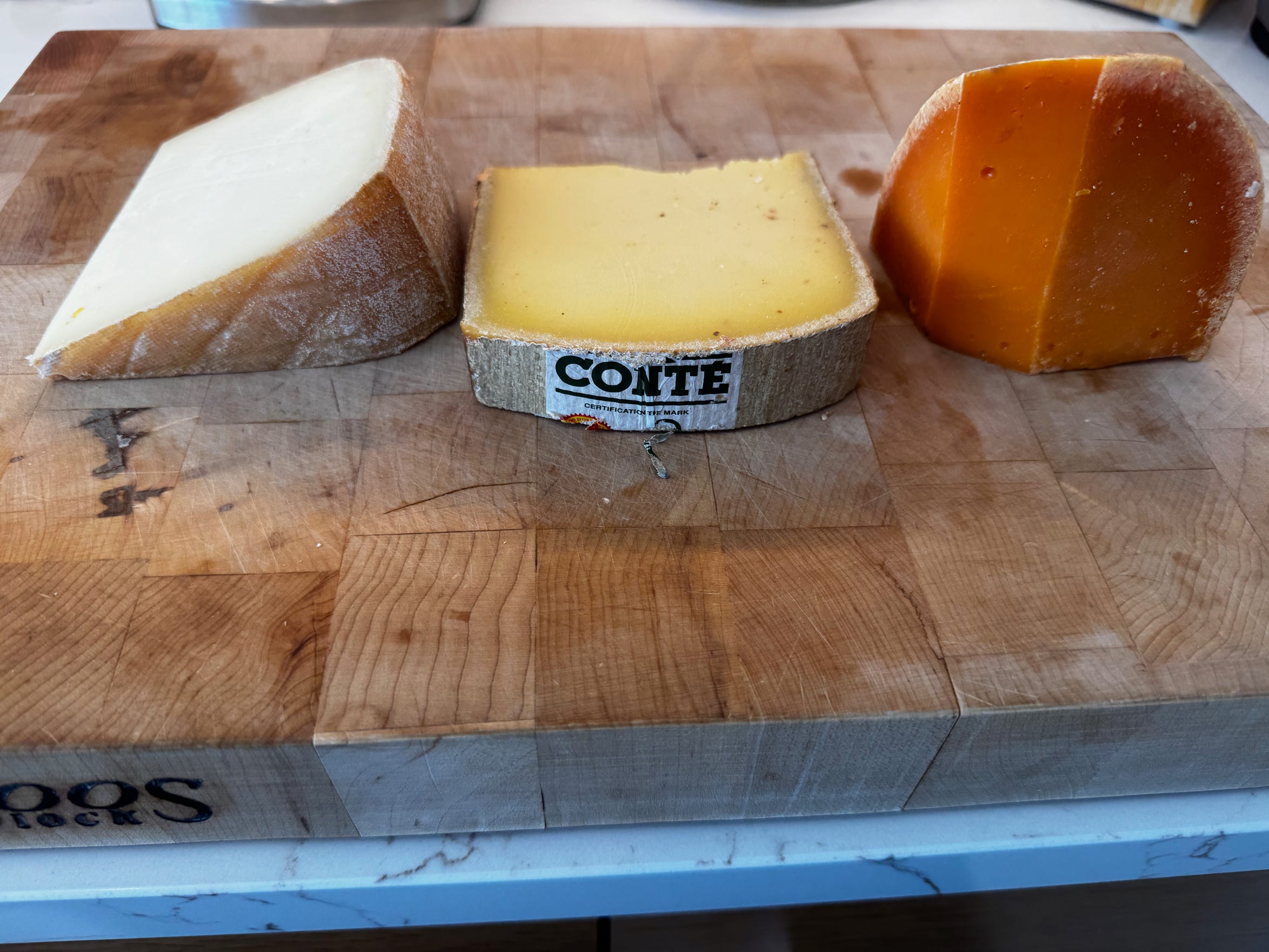January 10, 2024
Didn’t document the first part of the Zingerman’s Christmas present Cheese. This part arrived a couple of days ago, took poor, overworked Martin a while to get to it!

At the left is Brebis d'Ossau French Mountain Cheese. In the center is Comté Cheese from Fort St. Antoine. At the right is a Mimolette from France.
The Brebis d'Ossau is a bit skunky with an absolutely amazing nutty taste. Martin really likes this one! Zingerman’s description:
French mountain cheese from the Pyrenees.
From the pink and purple hydrangea-dotted mountainsides of the Pyrenees comes some of the best sheep’s milk cheeses France's Basque region has to offer.
These wheels are literally hand made. The cheese makers reach an arm into their kettle of warm curd and — ever so slowly — gently break it into the small pieces from which the final cheese will be formed. This ancient technique protects the fragile flavor of the finished cheese and enhances the quality of the full-flavored mountain milk. By using these old methods, a maker can get only two or three ten-pound wheels a day.
But the few cheeses made each day are marvelous. After at least six months of mellow maturing the cheese evolves into lovely, smooth, subtly fruity wheels with a nice little bit of a nose and a long, lingering sensual finish.
https://www.zingermans.com/Product/brebis-dossau-french-mountain-cheese/C-FMT
The Comté was really nutty and sweat, with a bit of a nip, Martin says. Not quite his style. Zingerman’s says this about it:
Lisa's favorite.
Lisa is our cheese specialist and food safety expert at Zingerman's Mail Order.
Recently I travelled to Marcel Petite’s Fort St. Antoine in Jougne, France where they age Comté cheese. This was a dream come true for me. Everyone acknowledges that the French make great cheese and Comté is king in France. Comté from Fort St. Antoine is the crown of the king and a trip there is like a cheesemonger's hajj. The Fort is special because it’s an ideal environment for very slow maturing of the wheels. Inside, the cheese can develop and express its individual flavors. Plus, it’s cool because it's really a fort! It was built into the side of a hill in the 1800’s and abandoned after it failed at its job stopping Germans in World War II.
Before I ever visited the Fort or even knew of it, I was already a Comté convert. I love this cheese because I think it’s just about perfect. It’s a wonderful balance of flavors that include hazelnut, brothy french onion soup and butter. It has the most delicate hint of sweetness and a super long finish. Perfecto!
https://www.zingermans.com/Product/comte-cheese-from-fort-st-antoine/C-COM
Finally the Mimolette. Wow! Martin approves of this cheese. Incredibly nutty and rich. Zingerman’s:
Forbidden cheese.
We often desire the forbidden and this is a cheese that was born of that very desire. In the 17th century, King Louis XIV banned Dutch Edam cheese in Flanders, the northernmost region of France. Missing the Dutch Edam, French cheesemakers reproduced it—but with a Gallic twist. They made the shape rounder, like a melon. And they added Roucou, known today as annatto, a natural red-orange dye from theseeds of the achiote tree, which made the cheese a bright orange color.
Mimolette is mild in flavor but it does possess an intense nutty, salty and fruity flavor, like pineapple. While it can be eaten when it’s young, unlike Edam, it is best when aged over 12 months. We've selected wheels for you that are aged closer to 14 months.
This cheese looks stunning on the plate with the deep orange color. It pairs very well with pale ales or rustic red wines like Cabernet Sauvignon and Quarts de Chaume.
https://www.zingermans.com/Product/mimolette-cheese-from-france/C-MIM